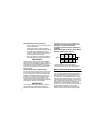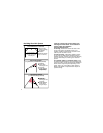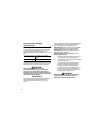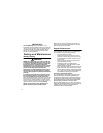
2
More specifically, install smoke alarms:
• On every level of your home, including finished
attics and basements.
• Inside every bedroom, especially if people
sleep with the door partly or completely closed.
• In the hall near every sleeping area. If your
home has multiple sleeping areas, install a unit
in each. If a hall is more than 40 feet long (12
meters), install a unit at each end.
• At the top of the first-to-second floor stairway,
and at the bottom of the basement stairway.
IMPORTANT!
Specific requirements for smoke alarm installation
vary from state to state and from region to region.
Check with your local Building Inspector and/or Fire
Department for current requirements in your area.
If you install AC or AC/DC units, it is recommended
(and may be required) they be interconnected for
added protection.
Installing Smoke Alarms in Mobile Homes
For minimum security install one smoke alarm as close
to each sleeping area as possible. For more security,
put one unit in each room. Many older mobile homes
(especially those built before 1978) have little or no
insulation. If your mobile home is not well insulated, or
if you are unsure of the amount of insulation, it is
important to install units on inside walls only. Smoke
alarms should be installed where temperatures normally
remain between 40˚F (4˚C) and 100˚F (38˚C)
.
IMPORTANT!
This equipment should be installed in accordance
with the National Fire Protection Association’s
Standard 72.
National Fire Protection Association,
One Batterymarch Park, Quincy, MA 02269-9101.
Additional local building and regulatory codes
may apply in your area. Always check
compliance requirements before beginning any
installation.
Smoke Alarms Recommended In Hotels, Motels,
Hospitals, Extended Care Facilities
Agency Placement Recommendations
NFPA Standard 72 Section 2-2.1.1.1
2-2.1.1.1 Smoke alarms shall be installed outside of
each separate sleeping area in the immediate vicinity of
the bedrooms and on each additional story of the
family living unit, including basements and excluding
crawl spaces and unfinished attics. In new construction
a smoke alarm shall also be installed in each sleeping
room. Chapter 2 also reads as follows: 2-2.2.1: In new
construction, where more than one smoke alarm is
required by 2-2.1, alarms shall be so arranged that
operation of any one alarm shall cause the operation of
all alarms within the dwelling. A-2.5.2.1 Smoke
Detection-Are More Smoke Alarms Desirable? The
required number of smoke alarms might not provide
RECOMMENDED STAND-ALONE
(NON-INTERCONNECTED)SMOKE ALARMS
HALLWAY
INDIVIDUAL ROOMS
LOBBY
Install stand-alone (non-interconnected)
AC powered smoke alarms with battery back-up
for maximum protection in each sleeping room.


















